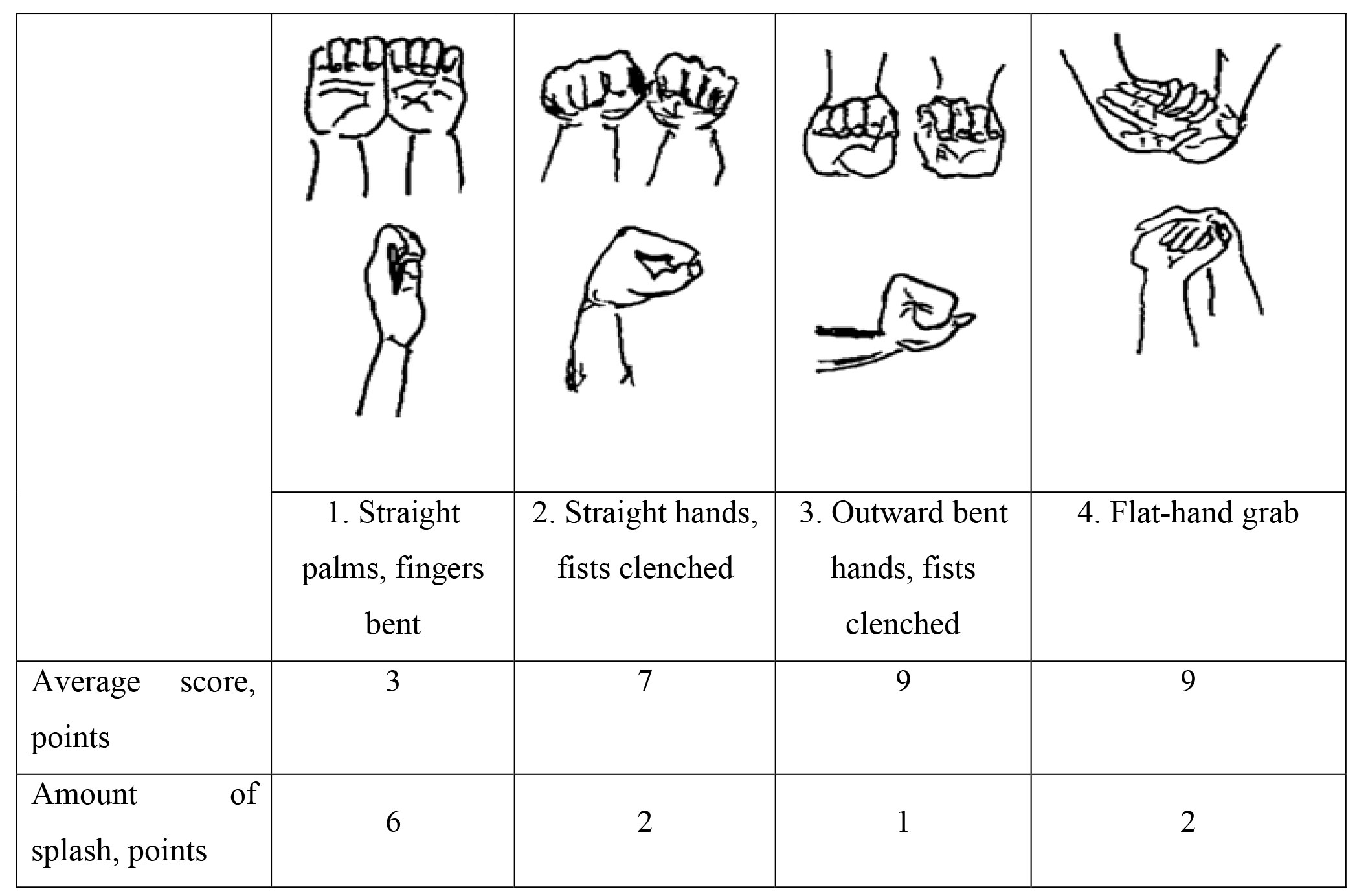Entry splash suppressing techniques in modern competitive diving
Фотографии:
ˑ:
Dr.Hab., Professor V.Yu. Karpov1
Dr.Hab., Professor E.A. Raspopova2
Dr.Hab., Professor О.N. Stepanova3
Master's student P.E. Kurkin4
1Russian State Social University, Moscow
2Russian State University of Physical Education, Sports, Youth and Tourism (SCOLIPE), Moscow
3Moscow State Pedagogical University, Moscow
4Moscow City Pedagogical University, Moscow
Keywords: entry, splash, dive, competitive diving.
Background. The modern diving techniques with their multiple somersault movements performed in dives from 1-10m high platforms and springboards are finalized by a vertical head- or feet-first entry, with the head-first entries dominating in contrast to many other sports [3, 5]. As provided by the modern rules of competitions, entries with large amounts of splash cannot be scored by more than 7 points [2], and that is the reason why a special priority in the elite diving techniques is given to this element. It should be noted, however, that the modern splash-minimizing techniques and the relevant training methods are still underexplored. There are a few study reports analyzing some hydrodynamic aspects of entry [1, 6, 7] and splash-generation regularities for solid objects falling in water. However, entries in the modern diving sport are much more complicated. As demonstrated by the experimental studies by L.Z. Gorokhovsky et al. [1], the diver’s body shall be analyzed as a controllable system with the relevant splash-control capacities and movements in the entry phase; albeit no detailed studies of the splash-control actions in the modern competitive diving from platforms and springboards have been made so far, and this was a subject matter for the present study.
The study was designed on the assumption that an ideal splash-free “rip entry” is largely achieved by a variety of special pre-and post-entry movements, with the entry splash-control movements being different for the forward and inward rotations.
Objectives of the study were to (1) identify the main splash-minimizing hand positions in the entry phase; and (2) analyze the splash-control movement sequences in cases of (a) front (forward) and (b) back (inward) rotations.
Methods and structure of the study. The research methods applied for the study purposes were as follows: underwater and surface video captures with the video data profiling and analyzing tools. The videos were captured in the elite divers’ training process by two video cameras installed on and under water surface to fix the divers’ pre- and post-entry movements. Excellent, very good, good, satisfactory, bad and very bad entries were scored by an expert team in the study by 10, 9-8, 7-6, 5, 4-3 and 2-0 points, respectively. The amount of splash was rated as follows: 0 points for no splash; 1-2 points for little splash with low fountain (high air cushion); 3-4 points for a moderate amount of splash; 5-6 points for a few average splashes; 7-8 points for high splashes; and 9-10 points for a very high splash with fountain. The video captures were analyzed with application of the Windows Media Player toolkit; with specific frames cut and analyzed by Paint.net; followed by the video material processing by the Movavi Video Editor toolkit. Sampled for the study purposes were 9 elite divers qualified Masters of Sports of Russia, with the individual anthropometric measurements classified for the study purposes, and with the entries upon forward and inward rotations recorded and analyzed.
Study results and discussion. As found in our previous study of the entry kinematics [4], the dives upon forward and inward rotations are normally 190-300cm and 180–280cm deep, respectively, with the entries upon the forward rotations most close to the vertical 90°. No statistically significant differences were found either in the forward- versus inward-rotation entry kinematics, or in the entry speeds; as speeds were found dictated by the platform/ springboard height rather than the rotation technique.
The underwater action analysis showed most of the elite divers (75%) making on entry a forward somersault with the arms spread sideways upon the forward rotations; whilst the inward rotations and entries were followed by underwater slides with the arms spread sideways or lowered in 100% of the cases.
We computed the rank correlation ratio to find correlation of the forward- versus inward-rotation entry qualities in the Experimental Group, with the rank correlation ratio estimated at r = 0.725 with p<0.05 that may be interpreted as indicative of the entry quality being largely dependent on the athlete’s anthropometric measurements and hands positions in the entry phase. The hands positions were analyzed by a special experiment, with the divers required to interlock or fix their hands and palms in different manners when hitting water as given in Table 1.
Table 1. Hands positions in the entry phase

Having analyzed the video captures, we found position 1 being difficult for the divers in terms of keeping their hands together; as the hands normally fly aside on the entry with the athlete’s body tipped under water to produce a splash fountain. Position 2 was found to generate smaller splash than Position 1 albeit more than Positions 3 and 4 – that are believed to be the best for the entry as verified by the splash scores. Most of the modern elite athletes in the top-ranking competitions prefer Position 4, particularly in dives from the high platforms. In addition, Versions 1-3 may result in hand injuries (dislocations, sprains) due to the hands twisted when entering water, particularly in case of dives from 10m-high platforms.
Conclusion
1. The study found that the entries upon forward rotations are always closer to the vertical than upon the inward ones, with the entry speeds being the same since they are dictated by the platform/ springboard height rather than the rotation technique.
2. The forward- versus inward-rotation entry qualities were found correlated with the rank correlation ratio estimated at r = 0.725 with p<0.05, with the finding interpreted as indicative of the entry quality being largely dependent on the athlete’s anthropometric measurements and hands positions in the entry phase.
3. The underwater action analysis showed most of the elite divers (75%) making a forward somersault on entry with arms spread sideways upon the forward rotations; whilst the inward rotations and entries were followed by underwater slides with the arms spread sideways or lowered in 100% of the cases.
4. The flat-hand grab position with one palm grabbing the other (extended in the wrist joint) to strike the water with a flat surface was found the most beneficial.
5. It was found that the elite athletes take splash-control underwater actions upon forward rotations with the arms spread sideways or lowering with a forward summersault.
References
- Gorokhovskiy L.Z., Shorygin O.P., Shulman N.A. et al. Issledovanie gidrodinamicheskikh usloviy vypolneniya «pogashennogo» vkhoda v vodu v pryzhkakh s tramplina i vyshki [Study of hydrodynamic conditions for "suppressed" diving in springboard and highboard dives]. Moscow: SCOLIPE, TsAGI publ., 1980, 33 p.
- Pravila FINA po pryzhkam v vodu i khaydayvingu 2013–2017 [FINA diving and highdiving rules 2013-2017 [Electronic resource]. Available at: http://www.divingpenza.ru/fina-trebovaniya/pravila-fina-po-pryzhkam-v-vo... (date of access: 09.01.2018).
- Raspopova E.A. Pryzhki v vodu. Uchebnik dlya vuzov fizicheskoy kultury [Highboard diving. Textbook for physical culture universities]. Moscow: Fizkultura, obrazovanie, nauka publ., 2000, 302 p.
- Raspopova E.A., Kurkin P.E. Kinematicheskie parametry dvizheniy sportsmenov, napravlennykh na snizhenie bryzgoobrazovaniya pri vypolnenii sportivnykh pryzhkov v vodu [Kinematic parameters of movements of athletes to reduce splash when diving]. Vestnik Moskovskogo gorodskogo pedagogicheskogo universiteta. Ser. Estestvennye nauki, 2017, no. 3, pp. 62–68.
- Stepanova O.N. Biomekhanicheskie osnovy tekhniki ottalkivaniya i metodika obucheniya pryzhkam v vodu s vyshki – poluoborotam II i III klassov. Avtoref. dis. kand. ped. nauk [Biomechanical basics of take-off technique and highboard diving teaching methods - II and III class back entries. PhD diss. abstract]. Moscow: RSAPE publ., 1995, 24 p.
- Moffatt H.K. Euler’s disk and its finite-time singularity. Nature, 2000, vol. 404, pp. 833–834.
- Gekle S., Gordillo J.M., van der Meer D., Lohse D. High-Speed Jet Formation after Solid Object Impact [Electronic resource]. Physical Review Letters, 102, 034502 (2009). Available at: https://link.springer.com/chapter/10.1007/978-3-642-01273-0_78 (date of access: 09.01.2018).
Corresponding author: fizkult@teoriya.ru
Abstract
Dives in modern competitive diving are scored by approach, flight and entry, with the divers entering water mostly in the head-first position in contrast to many other sport disciplines. A perfect splash-free “rip” entry is critical for a highly scored dive, and that is the reason why such high priority in the modern training systems is given to this very dive element. The amount of splash is controllable by a variety of entry techniques to be mastered for a competitive success. The article considers the splash-control pre- and post-entry (underwater) techniques applicable in the dives with back and front rotations. The authors conclude that the entry quality upon the front/back rotation dive is largely determined by body shape, line and pre-and post-entry actions.




 Журнал "THEORY AND PRACTICE
Журнал "THEORY AND PRACTICE